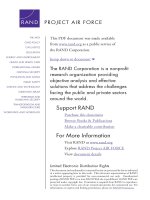Sharing Success--Owning Failure: Preparing to Command in the Twenty-First Century Air Force doc
Bạn đang xem bản rút gọn của tài liệu. Xem và tải ngay bản đầy đủ của tài liệu tại đây (399.67 KB, 131 trang )
Sharing Success—
Owning Failure
Preparing to Command in
the Twenty-First Century
Air Force
DAVID L. GOLDFEIN
Colonel, USAF
Air University Press
Maxwell Air Force Base, Alabama
October 2001
Disclaimer
Opinions, conclusions, and recommendations expressed or implied
within are solely those of the author and do not necessarily repre-
sent the views of Air University, the United States Air Force, the
Department of Defense, or any other US government agency.
Cleared for public release: distribution unlimited.
ii
Contents
Chapter Page
DISCLAIMER . . . . . . . . . . . . . . . . . ii
CONTENTS . . . . . . . . . . . . . . . . . . iii
FOREWORD . . . . . . . . . . . . . . . . . v
ABOUT THE AUTHOR . . . . . . . . . . vii
PREFACE . . . . . . . . . . . . . . . . . . . ix
ACKNOWLEDGMENTS . . . . . . . . . . xi
ABSTRACT . . . . . . . . . . . . . . . . . . xv
1 EXPECTATIONS OF COMMAND . . . 1
What Does the Boss Expect? . . . 2
What Do the Troops Expect? . . . 9
What Do You Expect? . . . . . . . . . 18
Notes . . . . . . . . . . . . . . . . . . . . 22
2 VISION AND ENVIRONMENT . . . . . 23
Developing and Communicating
Your Vision . . . . . . . . . . . . . . 24
Building the Environment . . . . . 30
Notes . . . . . . . . . . . . . . . . . . . . 49
3 WALKING THE WALK . . . . . . . . . . . 51
Notes . . . . . . . . . . . . . . . . . . . . 72
4 HANDLING JUSTICE . . . . . . . . . . . 73
iii
Chapter Page
5 GREAT IDEAS . . . . . . . . . . . . . . . . 95
Take Responsibility for Fun . . . . 95
Sponsor Program . . . . . . . . . . . . 100
Celebrate Heroes—Not
Machines . . . . . . . . . . . . . . . . 103
Mentoring Program . . . . . . . . . . 104
Notes . . . . . . . . . . . . . . . . . . . . 107
CONCLUSION . . . . . . . . . . . . . . . . 109
BIBLIOGRAPHY . . . . . . . . . . . . . . . 111
INDEX . . . . . . . . . . . . . . . . . . . . . 113
iv
Foreword
Command is the ultimate service. It is a
time when we have the singular responsibil-
ity to create and lead strong Air Force units.
A time when our passion for our Air Force
and our vision for its future must be over-
whelmingly clear.
Early in the “Developing Aerospace Lead-
ers” initiative, we began to focus on the way
in which the institution teaches leadership
and prepares airmen for command. What we
found was a wide range of practices and a
wide range of expectations—a complicating
factor in today’s Expeditionary Aerospace
Force.
We realize that preparing our officers to
command effective, mission-oriented units
must be a deliberate process. It must
develop our unique airman perspective, cre-
ating commanders who are able to commu-
nicate the vision, have credibility in the mis-
sion area, and can lead our people with
inspiration and heart.
The foundation of our institution’s effec-
tiveness has always been its leaders. Colonel
Goldfein’s work provides valuable lessons
learned and serves as a worthwhile tool to
optimize your effectiveness as a squadron
commander.
v
This book is a must–read, not only for
those selected to command a squadron but
for all our young officers, helping them
understand what the requirements of
squadron command will be. Remember,
command is a unique privilege—a demand-
ing and crucial position in our Air Force.
Sharing Success—Owning Failure takes
you a step closer to successfully meeting
that challenge.
Charles D. Link
Major General, USAF, Retired
vi
Colonel Dave “Fingers” Goldfein entered
active duty in 1983 following graduation from
the USAF Academy. He has completed a Mas-
ters in Business Administration, Squadron
Officer School, Air Command and Staff Col-
lege, Air War College, and the State Depart-
ment Senior Seminar.
Fingers earned his pilot wings at Shep-
pard AFB, Texas, in 1984 and remained
there as a first assignment instructor pilot
(FAIP) in the Euro-NATO Joint Jet Pilot
Training Program. Following Sheppard, he
checked out in the F-16 Fighting Falcon and
joined the 17th Tactical Fighter Squadron at
Shaw AFB, South Carolina. During this
tour, the squadron deployed to Abu Dhabi,
United Arab Emirates, where Fingers led his
vii
Colonel Goldfein with his fellow Aviano warriors during
Operation Allied Force
About the Author
flight on 40 combat missions over Iraq dur-
ing Operation Desert Storm.
Upon returning from the United Arab Emi-
rates, Fingers was selected for Weapons
School and reassigned as initial cadre to build
the composite wing at Mountain Home AFB,
Idaho. Flying with the 389th T-Bolts, Colonel
Goldfein served as squadron weapons officer
and then chief of wing weapons, tactics, and
intelligence.
Following Air Command and Staff College in
residence, Fingers served as Aide de Camp to
the Commander of AIRSOUTH in Naples, Italy,
and then as Executive Officer to the USAFE
Commander at Ramstein AFB, Germany.
In 1997, Colonel Goldfein re-qualified in the
F-16 and returned to Europe as Operations
Officer and then Commander of the 555th
Triple Nickel Fighter Squadron at Aviano AB,
Italy. As commander, Fingers led his squad-
ron on combat missions over Serbia, Kosovo,
and Bosnia-Herzegovina during Operation
Allied Force. He is a command pilot with over
3,500 flying hours. His decorations include the
Distinguished Flying Cross (1 OLC), Defense
Meritorious Service Medal, Meritorious Ser-
vice Medal (1 OLC), and Air Medal (5 OLC).
For 18 years and 13 moves, Fingers has
been married to Dawn (Thumbs). They are
the proud parents of two daughters,
Danielle and Diana. He currently serves as
deputy chief of Combat Forces Division at
Headquarters USAF, Pentagon.
viii
Preface
Congratulations on your selection for the
most challenging and rewarding job in the
Air Force—squadron command. The intent
of this paper is to help you prepare mentally
for the task ahead by discussing a few
themes central to a successful command
tour. It will not answer all of your questions
about “how to command”; nor will it break
any radically new ground in the “art of leader-
ship.” Rather, the ideas expressed here are
intended to spark your imagination as you
begin preparing now for how you want to
command your squadron.
These thoughts are not mine alone. In
researching this project, I asked officers from
across the Air Force, recently from command,
to share stories of the greatest challenges they
faced. What was the environment? How did
they react? Why did they choose a particular
path? Most importantly—what did they learn
from the experience? Many of the stories I
included in this paper involve situations in
which the individual failed. Why? Because it
is from studying our failures that we learn,
grow, and improve as officers and leaders.
As a commander, you will be privileged to
share in many successes of your organization;
however, you will personally own every fail-
ure. In the end, this is the true loneliness of
ix
command. Failure comes with risk and both
are integral to a successful command tour.
So read over the ideas presented here with
a critical eye and think now about how you
will react given similar circumstances. Ask
important questions such as: What are my
expectations of command? What do the
troops expect of me? What will be my vision?
How will I create an environment that
ensures mission success? How will I build
my team? How will I handle justice? Who is
ultimately responsible for fun in my
squadron? By thinking critically about these
questions now, you will be better prepared
to lead successfully in the greatest job you
will ever have.
Good luck commander!
Dave “Fingers” Goldfein
x
Acknowledgments
I am greatly indebted to the officers who
participated in this project. Sharing success
is relatively easy. Owning failure, however,
and then sharing the story of that failure in
a published paper takes courage and a com-
mitment to helping you succeed. Addition-
ally, this project was significantly improved
by the keen insight and editing skill of Maj
Gen Perry Smith, USAF, retired. His book,
Rules and Tools for Leaders, remains among
the most practical guides on command and
leadership written.
Maj Gen L. D. Johnston Maj Gen (retired) Perry M.
Smith
Maj Gen (retired) Chuck Link Maj Gen (retired) Bob
Taylor
Brig Gen Dan “Fig” Leaf Brig Gen (sel) Steve
“Goldy” Goldfein
Col Daniel “Doc” Zoerb Col Terry “Hubba” New
Col Jim “Rev” Jones Col Charlie “Clyon” Lyon
Col Judy Fedder Col Brian “Bbop” Bishop
Col Dave “Face” Nichols Col Anthony “Tony”
Rebello
Col Lansen Conley Col Mike “Boe” Boera
Col Jeff “Weird” Harrell Lt Col Jeff “Butkus”
Lofgren
Lt Col Bill “Bigfoot” Eliason Lt Col “Ragman” Harvey
Lt Col Theresa “Junior” Giorlando Lt Col Steve Laushine
Maj Duane “Imus” Creamer SMSgt John Long
SMSgt Michael Brake SMSgt Beverly Hill
SMSgt Christopher Schloemer MSgt Larry Johnson
xi
THIS PAGE INTENTIONALLY LEFT BLANK
Sharing Success—Owning Failure: Prepar-
ing to Command in the Twenty-First Century
was originally written as a research report for
the National Foreign Affairs Training Center,
Arlington, Virginia.
The photographs in this volume portray
Allied Forces personnel at Aviano Air Base,
Italy, during Colonel Goldfein’s tour of duty
as squadron commander, 555th Fighter
Squadron. All are USAF photographs.
xiii
THIS PAGE INTENTIONALLY LEFT BLANK
Abstract
The single most important element of suc-
cess in war is leadership. Leaders inspire
others to achieve “above and beyond.” The
expectations of both leader and follower play
key roles in the development of leadership,
as do the leader’s vision, the working envi-
ronment, and the example established by
the leader. The squadron commander is
essential to accomplishing the mission of
the United States Air Force. He or she must
ensure that justice prevails among and
between those commanded, and he or she
must establish programs that promote
health and happiness among the families
within the command.
xv
Chapter 1
Expectations of Command
Excellent leaders stand for absolute
integrity, absolute honesty. They
preach the concept of honesty in the
organization. Excellent leaders prac-
tice integrity in thought, word, and
deed. And they insist upon integrity
and honesty on the part of their sub-
ordinates.
—Gen W. L. Creech, USAF, Retired
Any dialogue on preparation for com-
mand must begin with a discussion on
expectations. No doubt you clearly
remember the day you were informed
that you had been chosen for command.
Anticipation mixed with pride and a fair
amount of uncertainty and fear—sound
familiar? This section will discuss some
key issues associated with what your
boss expects, what your troops expect,
and, perhaps most important, what you
can expect.
1
What Does the Boss Expect?
As a wing commander, the most
important personnel decision I ever
made was the selection of my
squadron commanders. No other
officer would have a greater positive
or negative effect on our ability to
accomplish the mission.
—Brig Gen Dan Leaf
—
31st Fighter Wing Commander
Leaders who hire subordinate com-
manders have a responsibility to clearly
lay out their expectations for success.
Too often, command in the Air Force is
viewed as a test of the individual for
future service rather than an opportu-
nity for the organization to succeed and
thrive under proven leadership. This
over-arching focus on testing the indi-
vidual rather than the success of the
unit has resulted over time in a corre-
spondingly shallow program to formally
prepare you for command.
A Navy officer who is chosen for a 36-
month command tour will spend the first
18 months as executive officer (focused on
learning the art of command) in the very
unit he or she will eventually lead. An
2
SHARING SUCCESS––OWNING FAILURE
Army or Marine officer will attend several
long training courses focused on com-
mand and leadership prior to accepting
the colors of his or her first unit. In con-
trast, Air Force officers selected for com-
mand are currently required to attend a
one-week major command (MAJCOM)
squadron commander’s course focused
largely on staying out of jail rather than
leading and managing effectively. This
lack of emphasis on thoroughly preparing
an individual to succeed in command sug-
gests an even greater need for you and
your new boss to establish mutually
understood expectations for success.
As you begin the transition process,
set up an appointment with your com-
mander. Ask about his or her expecta-
tions and indicate that you are open to
any advice—your commander has likely
been in your position. Do not arrive
without pen and pad in hand. One offi-
cer I know showed up for an interview
with his numbered Air Force com-
mander and was tossed out of the office
to find writing tools—definitely not the
way you want to begin your tour! The
bottom line: Do not leave the interview
until you understand clearly what is
expected of you.
3
EXPECTATIONS OF COMMAND
Sometimes, a face-to-face meeting is
not possible prior to a command change.
In these cases, send a note to your new
boss and request his or her thoughts on
success. Col William Lord, who served as
communications director for Headquar-
ters Air Mobility Command (HQ AMC),
outlined his expectations in a letter to
his new commanders. It helps them
chart their own course for success:
Congratulations on being named
squadron commander––it is the best
job in the Air Force, and the tough-
est. To help you get off on the right
foot, I’d like to offer some words to
help with your mental preparation.
To start with, you need a command
philosophy and initial focus. Three
reasons: (1) you only have one
chance at a first impression, (2) for
much of what you actually accom-
plish in your 2-year command tour,
you must first establish a focus in
your initial 6 months, and (3) your
first few weeks will haunt you if you
aren’t prepared. Those entrusted to
your charge want and need to be led
from day 1 of your command tour.
4
SHARING SUCCESS––OWNING FAILURE
Get to know and network with your
fellow commanders––irrespective of
career field, MAJCOM, or specialty.
If you succeed, you will become sen-
ior officers together before you know
it. You will need one another. If you
regard each other as competitors,
you will hurt yourselves, your com-
mand chain, and our Air Force.
Don’t get lost in the “glamour of
being the boss.” You’ll find the expe-
rience produces many rewards (not
awards) along with a good measure
of hard work and disappointments.
Now is a good time to send a short
thank you to family members and
any mentors that helped you during
your career. Don’t substitute with
email [sic]––the personal touch and
a hand-written [sic] note show good
breeding. If you haven’t sent a note
to your new boss and wing king, do
so––they selected you.
Take time to scrutinize your per-
sonal affairs. From relationships to
money matters, you need to be
squeaky clean. As a commander,
you will sit in judgment of others,
5
EXPECTATIONS OF COMMAND
and you cannot afford to surrender
the moral high ground––ever! You
are expected to be above reproach.
Your personal life won’t get you pro-
moted, but it can rapidly do you in.
Study up on your officers and senior
NCOs before you take command––
my office can help with personnel
briefs and RIPs. These are your
charges––worry about them, guide
them, and develop them to become
your replacement, or at least some-
one you’d be proud to have associ-
ated with your name. These troops
shouldn’t be worrying about their
next assignment––that’s your job.
Plan out your first 30 days now and
have in mind what you want to
accomplish. Some hints:
• Publish your command philos-
ophy.
• Meet with your Top 3 (or 4) the
first day.
• Visit every work center and
every shift. Keep these visits
regular.
6
SHARING SUCCESS––OWNING FAILURE
• Determine the areas you are
least comfortable with and
focus on these. Don’t be afraid
to ask questions––the troops
will respect your interest
• Meet all of your fellow com-
manders on their turf.
• Call on the Wing SEA, MPF
Flight Commander, Chaplain,
and all other agencies that
provide service to your unit.
• Inspect the dorm and eat in
the dining facility.
• Write job descriptions of each
of your key subordinates and
give them out one on one.
• Schedule a commander’s call
within the first month.
Take ownership of every part of your
organization and teach this to subor-
dinate leaders. Once you’ve walked
past trash on the ground, a wall that
needs paint, or a broken door, you’ve
just blessed it—and you’ll continue to
overlook it every day after that—until
it gets pointed out by your boss.
7
EXPECTATIONS OF COMMAND
Establish immediately that your
signed signature is your bond. It’s
hard to get credibility back once your
name becomes meaningless. Always
insist on putting the actual date of
signature on everything you sign.
Spouse involvement in unit and
base activities—there aren’t any
absolutes. The only wrong answers
are zero and everything. If your
spouse is a joiner and a doer,
encourage it. If not—don’t force it.
Just remember that taking care of
the families in your unit is an impor-
tant part of the job—we recruit indi-
viduals, but we retain families. How
you go about this will vary but the
responsibility will always exist. If not
your spouse, find someone who will
help you lead in this area.
Finally, be an officer and an airman
first—a communicator last. Aero-
space power is our business—com-
mand information is our contribu-
tion. Make a concerted effort to stay
current on operational issues and
doctrine. If you don’t understand
aerospace power application, it’s
8
SHARING SUCCESS––OWNING FAILURE
nearly impossible to effectively sup-
port the business.
Again, congratulations on your selec-
tion for command. I look forward to
working with you to accomplish our
mission.
1
Are there any questions as to what this
leader expects of his new commanders?
With a few personal touches, this letter
can serve as an excellent start for your let-
ter to subordinate leaders and supervi-
sors. Remember, establishing clear and
mutually understood expectations with
your flight commanders and flight chiefs
will be your responsibility as commander.
What Do the Troops Expect?
Good leaders are people who have a
passion to succeed . . . To become
successful leaders, we must first
learn that no matter how good the
technology or how shiny the equip-
ment, people-to-people relations get
things done in our organizations.
People are the assets that determine
our success or failure.
—Gen Ronald R. Fogleman, USAF, Retired
9
EXPECTATIONS OF COMMAND









